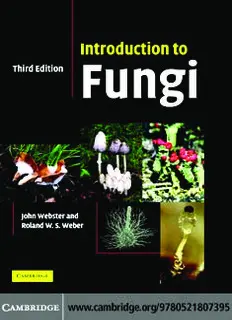
Introduction to Fungi, Third Edition PDF
Preview Introduction to Fungi, Third Edition
This page intentionally left blank Introductionto Fungi This new edition of the universally acclaimed and specially prepared drawings and photographs, widely used textbook on fungal biology has been based on living material. Illustrated life cycles are completely rewritten, drawing directly on the provided,andtechnicaltermsareclearlyexplained. authors’ research and teaching experience. The Extensivereferenceismadetorecentliteratureand text takes account of the rapid and exciting developments, and the emphasis throughout is on progress that has been made in thetaxonomy, cell whole-organism biology from an integrated, multi- and molecular biology, biochemistry, pathology disciplinary perspective. and ecology of the fungi. Features of taxonomic John Webster is Professor Emeritus of the School of significance are integrated with natural functions, Biosciences at theUniversity of Exeter,UK. including their relevance to human affairs. Special emphasis is placed on the biology and control of RolandW.S.WeberwasaLecturerintheDepartment human and plant pathogens, providing a vital ofBiotechnologyattheUniversityofKaiserslautern, link between fundamental and applied mycology. Germany, and is currently at the Fruit Experiment The book is richly illustrated throughout with station (OVB)in Jork,Germany. Introduction to Fungi JohnWebster University of Exeter and Roland Weber University of Kaiserslautern Third Edition CAMBRIDGEUNIVERSITY PRESS Cambridge, New York, Melbourne, Madrid, Cape Town, Singapore, São Paulo Cambridge University Press The Edinburgh Building, Cambridge CB2 8RU, UK Published in the United States of America by Cambridge University Press, New York www.cambridge.org Information on this title: www.cambridge.org/9780521807395 © J. Webster and R. W. S. Weber 2007 This publication is in copyright. Subject to statutory exception and to the provision of relevant collective licensing agreements, no reproduction of any part may take place without the written permission of Cambridge University Press. First published in print format 2007 ISBN-13 978-0-511-27783-2 eBook (EBL) ISBN-10 0-511-27783-0 eBook (EBL) ISBN-13 978-0-521-80739-5 hardback ISBN-10 0-521-80739-5 hardback ISBN-13 978-0-521-01483-0 paperback ISBN-10 0-521-01483-2 paperback Cambridge University Press has no responsibility for the persistence or accuracy of urls for external or third-party internet websites referred to in this publication, and does not guarantee that any content on such websites is, or will remain, accurate or appropriate. To Philip M. Booth Contents Prefacetothefirstedition pagexiii Prefacetothesecondedition xv Prefacetothethirdedition xvii Acknowledgements xix Chapter1 Introduction 1 1.1 What are fungi? 1 1.2 Physiology of the growing hypha 3 1.3 Hyphal aggregates 14 1.4 Spores of fungi 22 1.5 Taxonomy of fungi 32 Chapter2 Protozoa:Myxomycota(slimemoulds) 40 2.1 Introduction 40 2.2 Acrasiomycetes: acrasid cellular slime moulds 40 2.3 Dictyosteliomycetes: dictyostelid slime moulds 41 2.4 Protosteliomycetes: protostelid plasmodial slime moulds 45 2.5 Myxomycetes: true (plasmodial) slime moulds 47 Chapter3 Protozoa:Plasmodiophoromycota 54 3.1 Introduction 54 3.2 Plasmodiophorales 54 3.3 Control of diseases caused by Plasmodiophorales 62 3.4 Haptoglossa (Haptoglossales) 64 Chapter4 Straminipila:minorfungalphyla 67 4.1 Introduction 67 4.2 The straminipilous flagellum 68 4.3 Hyphochytriomycota 70 4.4 Labyrinthulomycota 71 Chapter5 Straminipila:Oomycota 75 5.1 Introduction 75 5.2 Saprolegniales 79 5.3 Pythiales 95 5.4 Peronosporales 115 5.5 Sclerosporaceae 125 viii CONTENTS Chapter6 Chytridiomycota 127 6.1 Introduction 127 6.2 Chytridiales 134 6.3 Spizellomycetales 145 6.4 Neocallimastigales (rumen fungi) 150 6.5 Blastocladiales 153 6.6 Monoblepharidales 162 Chapter7 Zygomycota 165 7.1 Introduction 165 7.2 Zygomycetes: Mucorales 165 7.3 Examples of Mucorales 180 7.4 Zoopagales 200 7.5 Entomophthorales 202 7.6 Glomales 217 7.7 Trichomycetes 222 Chapter8 Ascomycota(ascomycetes) 226 8.1 Introduction 226 8.2 Vegetative structures 226 8.3 Life cycles of ascomycetes 228 8.4 Conidia of ascomycetes 230 8.5 Conidium production in ascomycetes 231 8.6 Development of asci 236 8.7 Types of fruit body 245 8.8 Fossil ascomycetes 246 8.9 Scientific and economic significance of ascomycetes 246 8.10 Classification 247 Chapter9 Archiascomycetes 250 9.1 Introduction 250 9.2 Taphrinales 251 9.3 Schizosaccharomycetales 253 9.4 Pneumocystis 259 Chapter10 Hemiascomycetes 261 10.1 Introduction 261 10.2 Saccharomyces (Saccharomycetaceae) 263 10.3 Candida (anamorphic Saccharomycetales) 276 10.4 Pichia (Saccharomycetaceae) 281 10.5 Galactomyces (Dipodascaceae) 281 10.6 Saccharomycopsis (Saccharomycopsidaceae) 282 10.7 Eremothecium (Eremotheciaceae) 284
